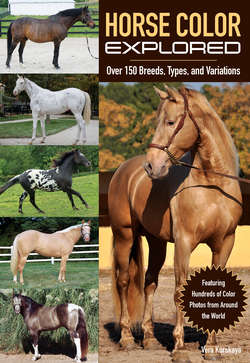Читать книгу Horse Economics - Vera Kurskaya - Страница 5
На сайте Литреса книга снята с продажи.
Preface
ОглавлениеI think my story is an unusual one. I am a Russian horsewoman, and I study horse colors, their variations, and the genetic mechanisms controlling them. I have always been interested in colors in a general sense, paying attention to those around me all the time. Surely, this linked to my love of horses and led to an interest in horse colors. But for a very long time my curiosity remained unsatisfied because of the lack of literature on the subject in my country.
When I was a teenager, I also dreamed of being a professional show jumper. But at the age of 20 an injury meant I couldn’t continue riding horseback any more. What could I do to keep horses in my life? I started reading every equine book and magazine I was able to get my hands on, and eventually, I came across an article about horse color genetics. I learned of a mysterious champagne color that existed but was not, however, well described. I was intrigued. I did my best to find information about the color, discovering there was a group of colors controlled by the Champagne gene. As I searched for the details, I was drawn deeper and deeper into the world of horse color—and I am absolutely sure it is an entire world! I started a blog explaining horse colors to others who felt an interest in the subject. People began to ask for my help in identifying colors and in predicting foals’ colors. Time passed, and some years after I first started my blog, I felt I had accumulated enough information to do what hadn’t yet been done: a specialty horse color book in Russian. And I felt the need to write it myself.
The first edition of my book was published in 2011, and it was so popular all the copies were sold in two months. A year later I published a revised version—and now you have an English edition in your hands.
More than 10 years have passed since the moment I started to study horse colors, and many things have changed for me. My published book has led to clinics at equine exhibitions, and what was a hobby at first grew into scientific work. I started my own research concerning the rare Silver gene in horse breeds originating in Russia. By 2015 I had discovered the Silver gene mutation and silver colors in Soviet Heavy Draft and Byelorussian Harness breeds. I can say that because of my work, the Soviet Heavy Draft stallion Ratoborets 2011 (Reketir—Rezonerka) became the first Russian horse registered in the studbook as silver bay (see p. 28). Such discoveries are very important for the rare or threatened horse breeds, as they can increase interest and thus the breeds’ chance of survival.
My research continues today. As of 2016, I became a post-graduate student at the Russian State Agricultural University named after K.A. Timiryazev, the oldest and the best agrarian university in my country. My thesis, of course, is devoted to my favorite subject—horse color identification.
I am so glad that my book is now published in the English language. When I first began studying horse color, most of my sources were in English because of lack of information in Russian. That is why my first aim was to tell something new to my native horsemen. Now I hope to say something new to English-speaking horsepeople around the world.
Writing and publishing a book is never an easy matter, and I am grateful to all the people who helped me with this process. I thank my husband for his patience, faith, and support. Thank you to Yevgeniy Matuzov for his interest in horse color genetics and generous support of my Silver gene research, and to Tatyana Zubkova for her Dun gene research, which is really important for the conservation of Russian Don and Budyonny breeds.
I especially thank Dr. Michal Prochazka, who respected my book enough to be so kind as to translate it into English. The English edition you are holding in your hands now would have been impossible without his participation.
I also thank Barbara Kostelnik for the effort she puts into her website devoted to rare horse color dilutions and for her kind help with the DNA test for the Iberian stallion Oro Mafiozo (see p. 37), Lee Patton and Holly Zech for their contribution to Oro Mafiozo’s test, and Yelena Volkova for her questions, which were always very difficult to answer, but I did my best, and they made me go out of my comfort zone and move far forward.
I thank all the owners, breeders, breed associations, and photographers from around the world who helped provide the photos for this book, and of course, I thank Trafalgar Square Books for making my book available for English-speaking horse people.
Vera Kurskaya
